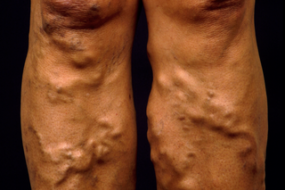Wilm’s tumor is a highly malignant embryonal neoplasm that develops from remnants of an immature kidney. It is also known as Nephroblastoma. It is located on one of the kidney poles.
Epidemiology
- It accounts for 6% to 7% of childhood cancers and 80% of kidney tumors
- The usual age of presentation is below 4 years
- May be present at birth
- Very rare in adults
- 50% of the cases involve the left kidney, 45% the right kidney, and 5% are bilateral
Pathology
- Grossly – smooth, pinkish white color and soft
- Microscopically – Malignant primitive glomeruli and primitive tubules, with epithelial and connective tissue cells
Associated anomalies
- Hypospadias
- Hemihypertrophy
- Cryptorchidism
- Neurofibromatosis
- Aniridia
- Beckwith-Wiedemann syndrome
Clinical features
- Palpable abdominal mass (most do not cross the midline).
- Haematuria (10-15% cases), gross pain, and fever
- Hypertension in over half of the cases is related to compression of the juxtaglomerular apparatus.
- Nonopacification on the urogram indicates tumor extension into the ureter and renal vessels.
- Signs of Beckwith-Wiedemann syndrome.
Diagnostic investigations
- Laboratory studies:
-CBC with differential for baseline data
-Platelet count: coagulation abnormalities
-Urinalysis for hematuria and urine culture
-Renal function tests
- Ultrasonography – initial diagnosis of a renal or abdominal mass
- CT scanning of chest and abdomen – differential diagnosis for kidney tumor and adrenal tumor
- Intravenous urography
- MRI
Stages of Wilm’s tumor and treatment
- Stage I – Tumour is limited to the kidney and is completely excised.
- Stage I I – Tumor extends beyond the kidney but is resectable
- Stage I I I – Residual nonhematogenous tumor after resection (tumor present at surgical margins, lymph node metastasis, or tumor spillage involving peritoneal cavity)
- Stage IV – Hematogenous metastases (lung, brain, liver, bone, and distant lymph nodes
- Stage V – Bilateral renal involvement
Differential diagnosis
- Mesoblastic nephroma
- Neuroblastoma
- Renal carcinoma
- Multicystic kidney disease
- Rhabdoid tumor of the kidney
Treatment
- Radical nephrectomy of the affected kidney with evaluation for staging
- Postoperative irradiation of tumor bed
- Chemotherapy – vincristine, doxorubicin
- Nephron sparing surgery in bilateral cases
Prognosis
- Pronostic factors include an extension of the tumor beyond the capsule, histologic pattern, and lymph node metastasis.
- 85% of patients have favorable histology(FH), which has an overall survival rate of 90%
- Patients with differentiated tumors have a 92% survival rate.












